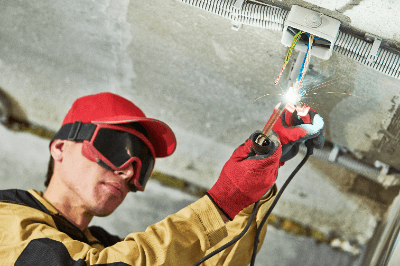What Is a Junction Box?

A junction box is a device that collects electricity from solar panels and channels it to a power conditioner.
In solar panel arrays, each solar cell block is connected in series, and their output is gathered in the junction box via diodes to prevent backflow. The DC from the junction box is then converted to AC by the power conditioner.
Inside the junction box, each block connects to a switchgear device, which functions similarly to a distribution board breaker. This setup allows for the monitoring of electricity flow.
Uses of Junction Boxes
Junction boxes are essential in high-voltage power generation systems, particularly in aggregating electricity from photovoltaic systems.
While junction boxes are available for both indoor and outdoor installations. However, outdoor use is more common. Typically installed in protected areas from rain, like under roof sheds or on exterior walls for easy maintenance, outdoor junction boxes are waterproof and tend to be more expensive. Indoor installations, however, require extensive wiring from the solar panels through large openings in exterior walls.
Principle of Junction Box
A string in a solar panel setup refers to a single circuit created by connecting several solar panels’ positive and negative poles in series with PV cables.
Each string, which may comprise up to 20 solar panels, connects to a small breaker inside the junction box. Multiple strings can be wired to a single large breaker. The junction box consolidates multiple thin PV cables into one thick cable leading to the power conditioner. Without the junction box, connecting all PV cables directly in series to the power conditioner could lead to power loss due to voltage drop. Thin PV cables in a string are unsuitable for long-distance wiring.
Providing a small breaker for each string allows for targeted maintenance and part replacements, like solar panels, without shutting down the entire power system. To protect against equipment damage during lightning strikes, lightning protection elements are also incorporated.
Types of Junction Boxes
Junction boxes come in various types, such as plastic, metal, explosion-proof, and relay boxes with terminals.
1. Junction Box for VVF
These are specifically designed for VVF wires and are generally made of resin. They facilitate the piercing and connection of VVF wires.
2. Outlet Box/Pull Box
Commonly used in factories and outdoor settings, these junction boxes connect to thin steel, VE pipes, or other conduit pipes. They act as relay points where cables inside the box are connected, branched, and redirected through different conduits.
Drip-proof versions suitable for outdoor use are available, along with models featuring multiple terminals for easy wiring changes and branching.
3. Junction Boxes With Explosion-Proof Construction
Used with thick steel conduit pipes, these are designed for environments with flammable gases, like chemical plants and hazardous material storage facilities. They feature sealed construction to prevent ignition caused by electricity, robust structure, and packing-type cable glands for wire entry. All openings, including lids, are sealed with packing.
4. Round Exposed Box
A round exposed box, also known as a round box, is commonly used in remodeling and factory wiring. The body and lid are typically connected with screws at the top and bottom. Smaller than pull boxes and other types, they are used for smaller-scale wiring connections. The lower part of the box often has openings on all sides for drainage.
How to Select a Junction Box
Choosing the right junction box is critical to efficiently channel solar-generated power to the power conditioner without loss. Consider waterproofing, drip-proofing, voltage boosting, heat dissipation, and maximum input voltage. A highly functional junction box reduces energy loss but should match the system’s capacity without being excessive.
For example, a high maximum input voltage allows for designing a single block with high voltage, grouping more panels per block, reducing parallel connections, and minimizing power loss.
Structure of Junction Box
The typical junction box contains lightning protection elements, switchgear or circuit breakers, a terminal block for output, backflow prevention elements, and DC switchgear for input.
Lightning protection elements safeguard against strikes, while the switchgear, similar to a breaker, allows for current monitoring and maintenance. Some junction boxes integrate with power conditioners, eliminating the need for separate junction box installation. As they are generally outdoor installations, protection against rainwater and dust ingress is essential.